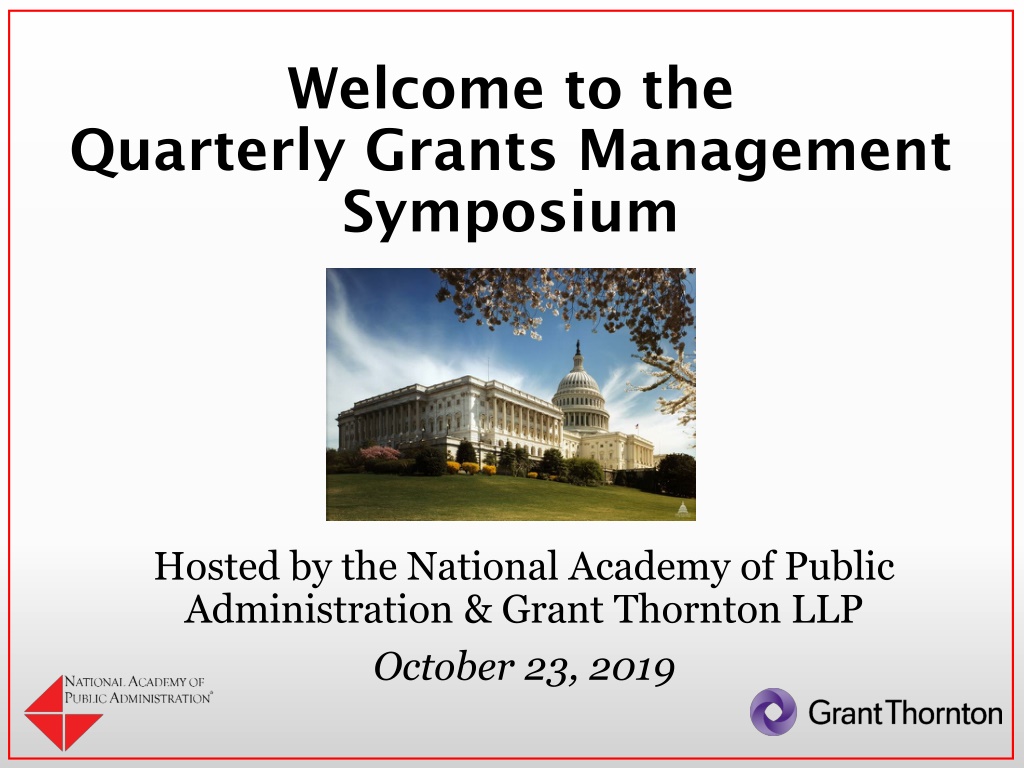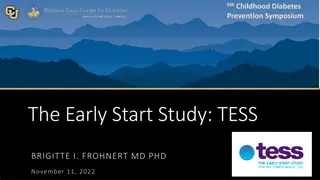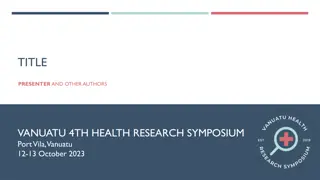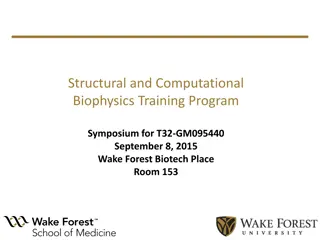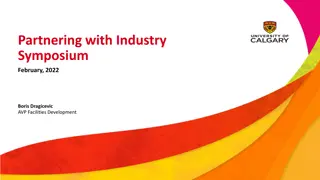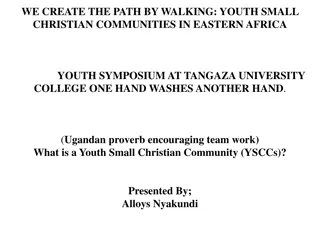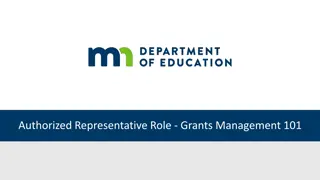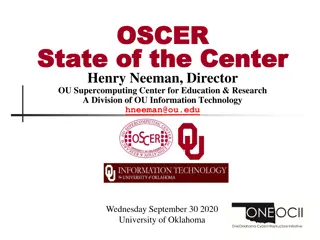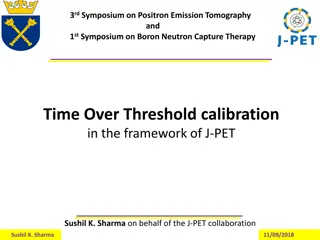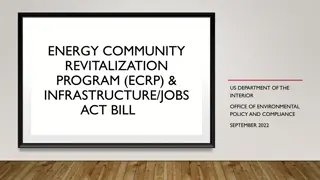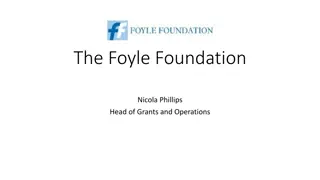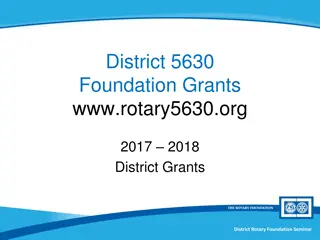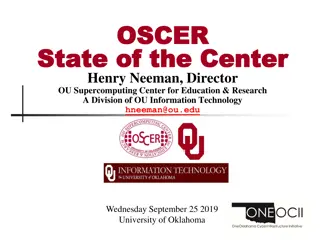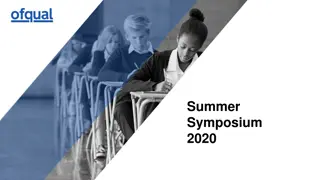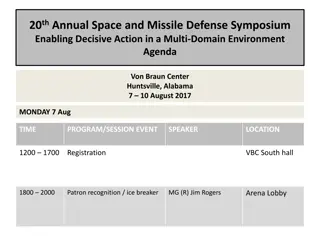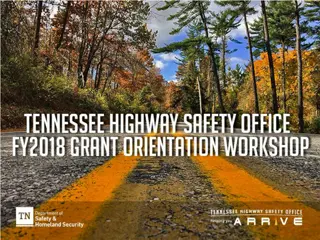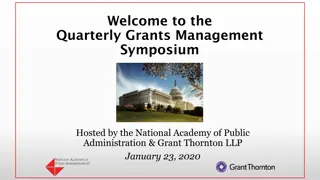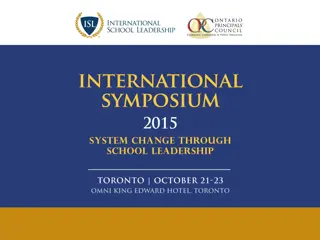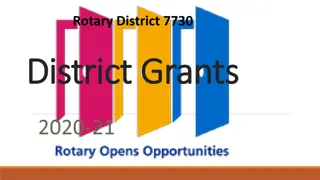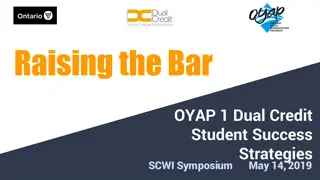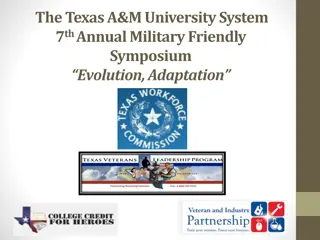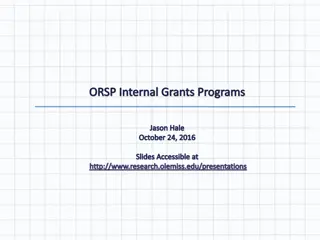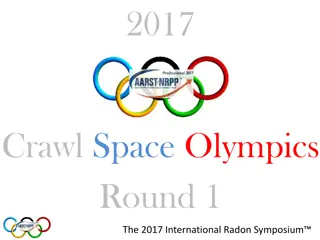Quarterly Grants Management Symposium Overview
This symposium, hosted by the National Academy of Public Administration and Grant Thornton LLP, aims to facilitate collaborative discussions for knowledge sharing and problem-solving in grants management. The event gathers subject matter experts, thought leaders, and policymakers to exchange best practices, develop new methodologies, and enhance grant outcomes. With a focus on reducing inefficiencies and improving financial assistance awards, the symposium provides a forum for influencing change and promoting best practices. Sessions are held quarterly at the National Academy of Public Administration's headquarters in Washington, DC.
- Grants Management
- Symposium
- National Academy of Public Administration
- Grant Thornton LLP
- Knowledge Sharing
Download Presentation

Please find below an Image/Link to download the presentation.
The content on the website is provided AS IS for your information and personal use only. It may not be sold, licensed, or shared on other websites without obtaining consent from the author. Download presentation by click this link. If you encounter any issues during the download, it is possible that the publisher has removed the file from their server.
E N D
Presentation Transcript
Welcome to the Quarterly Grants Management Symposium Hosted by the National Academy of Public Administration & Grant Thornton LLP October 23, 2019
Agenda Start Time End Time Topic Speaker Networking Breakfast 8:45 AM 9:00 AM Joe Mitchell, Director of Strategic Initiatives, National Academy of Public Administration Dale Bell, Director, Division of Institution & Awards Support, National Science Foundation 9:00 AM 9:10 AM Welcome Research University Perspective Alexandra Albinak, Executive Committee, Federal Demonstration Partnership 9:10 AM 9:40 AM Jean Feldman, Head, Policy Office, Institution and Award Support, National Science Foundation 9:40 AM 10:10 AM Federal Perspective 10:10 AM 10:45 AM Q&A/Discussion 10:45 AM 10:50 AM OMB Remarks Rhea Hubbard John Kamensky, Chair of Executive Organization and Management Panel Co-Authors of the Report 10:50AM 10:55 AM Report Summary Wendy Morton-Huddleston, Principal, Grant Thornton 10:55 AM 11:00 AM Next Steps 2
Grants Management Symposium Overview Objective Collaborative discussion to foster knowledge sharing and problem solving of critical issues in the grants management community. Benefits Government to government exchange of best practices and lessons learned to address common challenges Access to broad audience of subject matter experts & thought leaders from NAPA, public and private sectors, policymakers, nonpartisan non- profit state & local organizations (i.e. the Big Seven), and OMB A forum to influence and promote change, develop new methodologies and best practices, reduce inefficiencies, enhance grant outputs and improve Government ROI on financial assistance awards Outcome Tangible artifacts that can be implemented (e.g. whitepaper shared on OMB MAX.gov) Frequency & Location Quarterly 2-hour sessions located at the National Academy of Public Administration's headquarters, 1600 K Street, NW, Washington, DC 3
Alexandra Albinak Executive Committee, Federal Demonstration Partnership Associate Vice Provost for Research Administration, Johns Hopkins University 4
Federal Demonstration Partnership (FDP) Presentation to the National Academy of Public Administration Quarterly Grants Management Symposium October 23, 2019 Alexandra M. Albinak FDP Executive Committee Co-Chair, Research Compliance Co-Chair, Contracts Associate Vice Provost for Research Administration Johns Hopkins University
Agenda Overview of FDP Activities Committees Phase VII Planning Demonstration of the Clearinghouse Q&A
What is FDP? A cooperative initiative convened by the Government- University-Industry Research Roundtable (GUIRR) of the National Academies of Sciences, Engineering and Medicine (NAS) Membership meets in Washington D.C. three (3) times a year: September, January, May Attendees include federal agency officials and university administrators, faculty and electronic research administration managers
What is the FDP? FDP mission Researchers doing science, not administration Association of federal agencies, academic and nonprofit research institutions, and research policy organizations that work together in a collaborative initiative to streamline the administration of federally sponsored research Improving the productivity of research without compromising its stewardship A unique forum for individuals from universities and nonprofits to work collaboratively with federal agency officials to improve the national research enterprise
HISTORY OF THE FDP Phase VI: 2014-2020 Phase V: 2008-2014 Phase IV: 2002-2008* Phase III: 1996-2002 Phase II: 1988 Federal Demonstration Partnership Phase I: 1986 Florida Demonstration Project Pre-FDP: 1985 Hearing and Report by GUIRR 9
History of Success Expanded Authorities Standard Federal Research Terms and Conditions FDP Subaward Agreement Templates Standard Government-wide Terms and Conditions Faculty Burden Survey FDP Clearinghouse for Financial Conflict of Interest (now Expanded Clearinghouse) NAS Reports on Reducing Administrative Burden 10
Membership 154 Members 212 individual organizations Includes 26 Emerging Research Institutions 10 Federal Agencies NSF, NIH, ONR, USDA, AFOSR, ARO, AMRMC, NASA, EPA and DHS
Expectations of Members Representatives are expected to: Attend regular FDP meetings. Participate on committees. Expenses for attendance are borne by the institutions Participate on working groups and task forces. Serve as advocates for their colleagues. 12
Activities At its regular meetings, faculty and administrators talk face- to-face with decision-makers from agencies that sponsor and regulate research Test new ways of doing things in the real world before putting them into effect The focus is on the entire life cycle of the research project DEMONSTRATIONS
Committee Types In addition to the overarching Executive Committee, the FDP has three Operational Committees: Finance Communication Membership There are also six Programmatic Committees, each with their own subcommittees and working groups: Faculty eRA Research Administration Finance/Costing/Audit Research Compliance ERI
EXECUTIVE COMMITTEE Provides general direction of FDP activities: Two (2) institutional members (one faculty, one research administrator) Chair Administrative Representative; Vice-Chair Faculty Representative Senior Federal Official Director of the National Academies Government-University-Industry Research Roundtable (GUIRR) The FDP Executive Director One (1) senior federal science official (appointed by the Office of Science and Technology Policy) Co-chairs from each of the FDP operational/programmatic committees Additional representatives as appointed by Chair 16
MEMBERSHIP COMMITTEE Responsible for membership issues affecting FDP activities: Conducts new attendee activities at meetings Evaluates/recommends requests for additional affiliate membership Encourages increased federal participation Facilitates transition process for new FDP phases Oversees nomination/election procedures Supports ERI s participation Manages annual reporting process 17
FINANCE COMMITTEE Responsible for FDP financial issues: Reviews annual budgets Sets financial-related policies and procedures Monitors the payment of dues 18
COMMUNICATIONS COMMITTEE Responsible for the FDP public image: Approves FDP publications (printed or electronic) Provides direction for the FDP web site Oversees the FDP Biannual Report Compiles/disseminates meeting proceedings Develops/distributes outreach materials 19
FACULTY COMMITTEE Serves as the forum for faculty representatives: Provides faculty input on all FDP activities Shares information from other operational and programmatic committees Incubates and develops new activity proposals Develops surveys of faculty at member institutions to garner necessary information to direct proposed activities 20
ERA COMMITTEE Works to identify opportunities to reduce administrative burden in electronic processes and communications: Informs the federal e-grants activities by providing institutional input Supports the development of improved electronic interfaces between the government and the research community Provides IT consultation for demonstrations, pilots, and committees as requested Examines ways for FDP to best function in the digital age 21
ERA COMMITTEE Current Initiatives: JAD Joint Application Design team with Grants.gov SciENcv Science Experts Network Curriculum Vitae (Researcher Profile Portal) Requirements for research management systems Survey on Applicant Investment in Grants.gov Grant Reporting Information Project (GRIP) Agency Matrix Working Group 22
RESEARCH ADMINISTRATION COMMITTEE Identifies opportunities to make federal administrative requirements simpler and less costly without compromising accountability. Current Initiatives: Data Transfer and Use Agreement Open Government: Research Administrative Data Subaward Templates Expanded Clearinghouse 23
FINANCIAL, AUDIT & COSTING POLICY COMMITTEE Explores opportunities to simplify financial, audit, or cost policies without compromising accountability. Current Initiatives: Administrative Cost Working Group Project Certification Procurement Standards Working Group 24
RESEARCH COMPLIANCE COMMITTEE Reviews existing and new requirements imposed by federal regulations in areas including: Human research participant protections, animal use and care, conflicts of interest (individual, organizational and institutional), objectivity in research and export controls Efforts focus on: Identifying and harmonizing requirements across federal agencies Reducing redundancies and unnecessary burdens Seeking effective practices for implementing compliance requirements 25
RESEARCH COMPLIANCE COMMITTEE Current Initiatives: IRB Wizard Demonstration Organizational Conflict of Interest Foreign Influence (Conflict of Commitment) Data Transfer and Use Agreement Pilot Compliance Unit Standard Procedure (CUSP) Subawards/MOU for Animal Care
EMERGING RESEARCH INSTITUTION COMMITTEE Encourages and facilitates ERI representation in FDP demonstrations, committees, working groups. Efforts focus on: Identifies ERI characteristics relevant to FDP goals Broadens knowledge about ERIs by non-ERI members Works with federal agency partners to increase mutual knowledge regarding agency practices and ERI challenges Reviews data from FWS and Biannual Report containing ERI membership feedback to understand ERI characteristics and needs
PHASE VII STRATEGIC PLAN Mission Vision Goals for Phase VII
PHASE VII UPDATED MISSION Researchers doing research, not administration Core Purpose: To streamline the administration of federally funded sponsored research and foster collaboration to enhance the national research enterprise, while maintaining high standards of stewardship and accountability.
GOALS FOR Phase VII 1. Demonstrate positive impact on administrative efficiency and effectiveness 2. Institutionalize evaluation to measure the relevance and impact of FDP 3. Strengthen resources and infrastructure to sustain FDP growth 4. Actively engage community partners administrators, faculty, and federal representatives 5. Tell a powerful FDP story to internal and external audiences
NEXT STEPS 1. Changes to FDP being implemented now based on process Chair/Vice Chair Co-Chair system Establish Infrastructure Committee Adopt new Membership structure and fee system Enhance the use of communication technologies to foster collaboration away from meetings Continue outreach to Federal Partners to increase participation Continue outreach to faculty to ensure full participation and full representation of each institution 2. Implement remaining elements of the Strategic Plan through end of Phase VI and start of Phase VII 3. Announce the roadmap to the implementation of Phase VII
EXPANDED CLEARINGHOUSE FDP Expanded Clearinghouse for Subrecipient Monitoring
Expanded Clearinghouse Subrecipient Monitoring Programs include forms, forms, and more forms: Entity-based data to perform risk assessment Project-based information to perform non fiscal/audit compliance and risk assessment reviews per project Annual audit updates Conflict of interest forms Collected at various times, sometimes multiple times per project Entity Information typically not maintained centrally (even if electronic, only allow one person to complete form or include other limitations)
Expanded Clearinghouse Goals Create and maintain one single, publicly available, web-based repository for all FDP entities (and potentially others) to enter, maintain and update all entity related information about their organization, to Enable Pass-Through Entities (FDP and Non-FDP) to obtain and review all necessary entity-level information for their subrecipient entity monitoring and risk assessment activities in a timely and streamlined fashion without requiring the time and resources to send, populate, receive and review forms on every transaction to obtain that same information
PILOT PHASES (July 1, 2016 June 30, 2017) Phase I Eliminate use of subrecipient commitment forms in favor of a national online repository Test the feasibility of a data repository, and whether it effectively reduces the burden of data collection and review for pass-through entities and subrecipients alike, while still ensuring stewardship over federal funding Phase II Create a more robust web-based system to house entity profiles and allow for real-time updates, secure certification of information, and ease of use for both Clearinghouse participants and others looking for up-to- date information
PILOT RESULTS Piloteers: 127 campuses of 111 FDP institutions Exchanged 10,800 transactions Results: oEstimated saving 1.6 hours/transaction oSaved more than 17,500 staff hours oReported a 98.6% user satisfaction rate oGained deeper understanding of transactions: 34% new subs, 51% mods, remaining = unknown 62% DHHS (mainly NIH), 12% private, remaining = variety 81% grants, 11% cooperative agreements, 6% contracts 91% cost-reimbursement, 4% fixed price
2019 INITIATIVES Current initiatives include: First group of non-FDP Cohort successfully enrolled 234 Profiles, including 20 non-FDP members Generating list of interested future enrollees Data integrity enhancements validations/notifications Raising awareness with Federal agencies Formally established as an FDP subcommittee Future initiatives include: Planning for FDP Phase VII Interface with federal systems (e.g. SAM.gov & Federal Audit Clearinghouse) Merging FDP data sources into EC Capacity for non-single audit orgs?
EXPANDED CLEARINGHOUSE https://fdpclearinghouse.org/
QUESTIONS? Alexandra M. Albinak amckeown@jhu.edu 443-997-1898 FDP Staff Contact David Wright FDP Executive Director dwright@nas.edu Lillian Andrews Senior Program Assistant landrews@nas.edu
Jean Feldman Head, Policy Office, Division of Institution & Award Support, National Science Foundation 40
Grants Management Symposium National Academy of Public Administration Lessons Learned for Driving Change A Research Community Perspective October 23, 2019 Jean Feldman Head, Policy Office Division of Institution & Award Support policy@nsf.gov National Science Foundation
Formal Mechanisms for Driving Federal Change Statutes/Regulations Uniform Administrative Requirements (2 CFR 200) National Science Foundation President s Management Agenda Cross Agency Priority Goals NSTC Interagency Workgroup Coordinating Administrative Requirements for Research (CARR) Previously the Research Business Models subcommittee Individual Agency Requirements
Federal Research Community Collaborative Accomplishments Government-wide grant application for research (SF 424 R&R) National Science Foundation Research terms and conditions (RTC) for OMB Circular A-110 and Uniform Guidance RTC Appendices Research Performance Progress Report (RPPR) Interim and Final
Lessons Learned for Driving Change in the Research Community One size does not necessarily fit all and does not always lead to burden reduction Sometimes no agreement is agreement Invest up front in engagement (both between agencies and with our partners) Realize that you need to be in it for the long haul Get the right people at the table Establish and maintain relationships Set up protocols for sharing information, developing options, and achieving consensus National Science Foundation
Discussion 45
2018 2019 Recap & Looking Forward Highlights Five sessions held in 2018 2019. More than 150 attendees from agencies as well as stakeholders/recipients. Speakers included: o Federal: OMB, HHS, GAO, NSF, ED, DOI etc. o State & Local: Allegheny County Department of Human Services, Fairfax County, Virginia Department of Social Services, etc. o Industry: UPMC Health Plan, Mission Measurement, American Public Human Services Association (APHSA), etc. Accomplishments: Engaged Office of Management and Budget's President's Management Agenda (PMA) Cross Agency Priority Goals: o OMB shared prospective PMA CAP Goal 8 Results-oriented accountability for grants, OMB M-18-24, Strategies to reduce grant recipient etc. to gain agency & stakeholder input. Allowed critical engagement & dialogue between Federal Agencies and recipients: o Representatives from Allegheny County DHS, UPMC Health Plan, APHSA provided their perspective & challenges with demonstrating accountability for their grants programs at the State & Local Level. OMB Takeaways Utilize CAP goal 8 & NAPA cohort collaboration to: o Develop strategy to engage this stakeholder community, o Gain more input on the grants skills gap in the community, and o Establish data standards for grants. 2019 2020: Planned Actions/Outcomes Develop tangible & implementable artifacts (i.e. whitepapers, visualization tools, shared knowledge repository etc.). Establish Special Interest Groups (SIG) that focus on: o Thought Leadership o Explore Grants automation (robotics, AI and blockchain) o Develop Grants Management Playbook Utilize NAPA cohort relationships to engage Congressional Decision makers & Staff via to drive grants policy making. 46
Thank you! Please fill out the survey cards at your seat and return to the check-in table once you are finished. 47
